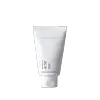What's inside
What's inside
 Key Ingredients
Key Ingredients

 Benefits
Benefits

 Concerns
Concerns

 Ingredients Side-by-side
Ingredients Side-by-side

Water
Skin ConditioningGlycerin
HumectantDipropylene Glycol
HumectantSodium Cocoamphoacetate
CleansingChondrus Crispus
MaskingPotassium Cocoyl Glycinate
Sodium Lauroyl Sarcosinate
CleansingPotassium Cocoate
EmulsifyingDecyl Glucoside
CleansingSodium Polyacrylate
AbsorbentPropanediol
SolventXanthan Gum
EmulsifyingTrehalose
HumectantDipotassium Glycyrrhizate
HumectantSodium Lauroyl Glutamate
Acacia Senegal Gum
MaskingDecylene Glycol
Skin ConditioningGlyceryl Caprylate
EmollientSerenoa Serrulata Fruit Extract
Skin ConditioningCinnamomum Cassia Bark Extract
MaskingHydrated Silica
AbrasiveButylene Glycol
HumectantBetaine
HumectantSapindus Mukorossi Peel Extract
Skin ConditioningPanthenol
Skin ConditioningSodium PCA
HumectantChondrus Crispus Extract
Skin Conditioning1,2-Hexanediol
Skin ConditioningEscin
TonicSorbitol
HumectantThreonine
Arginine
MaskingLysine
Skin ConditioningAlanine
MaskingGlutamic Acid
HumectantGlycine
BufferingSerine
MaskingProline
Skin ConditioningRuscus Aculeatus Root Extract
AstringentAmmonium Glycyrrhizate
MaskingPhenoxyethanol
PreservativeCentella Asiatica Leaf Extract
Skin ConditioningHydrolyzed Yeast Protein
Skin ConditioningCalendula Officinalis Flower Extract
MaskingHydroxyacetophenone
AntioxidantGluconolactone
Skin ConditioningSodium Citrate
BufferingSodium Benzoate
MaskingSodium Hyaluronate
HumectantWater, Glycerin, Dipropylene Glycol, Sodium Cocoamphoacetate, Chondrus Crispus, Potassium Cocoyl Glycinate, Sodium Lauroyl Sarcosinate, Potassium Cocoate, Decyl Glucoside, Sodium Polyacrylate, Propanediol, Xanthan Gum, Trehalose, Dipotassium Glycyrrhizate, Sodium Lauroyl Glutamate, Acacia Senegal Gum, Decylene Glycol, Glyceryl Caprylate, Serenoa Serrulata Fruit Extract, Cinnamomum Cassia Bark Extract, Hydrated Silica, Butylene Glycol, Betaine, Sapindus Mukorossi Peel Extract, Panthenol, Sodium PCA, Chondrus Crispus Extract, 1,2-Hexanediol, Escin, Sorbitol, Threonine, Arginine, Lysine, Alanine, Glutamic Acid, Glycine, Serine, Proline, Ruscus Aculeatus Root Extract, Ammonium Glycyrrhizate, Phenoxyethanol, Centella Asiatica Leaf Extract, Hydrolyzed Yeast Protein, Calendula Officinalis Flower Extract, Hydroxyacetophenone, Gluconolactone, Sodium Citrate, Sodium Benzoate, Sodium Hyaluronate
Water
Skin ConditioningCocamidopropyl Betaine
CleansingSodium Methyl Oleoyl Taurate
CleansingPEG-75
HumectantAcrylates Copolymer
Glycerin
HumectantDisodium Cocoamphodipropionate
CleansingPEG-120 Methyl Glucose Dioleate
EmulsifyingDimethyl Sulfone
SolventPyridoxine Hcl
Skin ConditioningSalix Alba Bark Extract
AstringentForsythia Suspensa Fruit Extract
AntioxidantButylene Glycol
HumectantCentella Asiatica Extract
CleansingPolygonum Cuspidatum Root Extract
AntioxidantScutellaria Baicalensis Root Extract
AstringentCamellia Sinensis Leaf Extract
AntimicrobialGlycyrrhiza Uralensis Root Extract
Skin ConditioningChamomilla Recutita Flower Extract
MaskingRosmarinus Officinalis Leaf Extract
AntimicrobialSodium Chloride
MaskingCopper Tripeptide-1
Skin ConditioningAllantoin
Skin ConditioningCitric Acid
BufferingPotassium Hydroxide
BufferingSodium Benzoate
MaskingPhenoxyethanol
PreservativeDisodium EDTA
Water, Cocamidopropyl Betaine, Sodium Methyl Oleoyl Taurate, PEG-75, Acrylates Copolymer, Glycerin, Disodium Cocoamphodipropionate, PEG-120 Methyl Glucose Dioleate, Dimethyl Sulfone, Pyridoxine Hcl, Salix Alba Bark Extract, Forsythia Suspensa Fruit Extract, Butylene Glycol, Centella Asiatica Extract, Polygonum Cuspidatum Root Extract, Scutellaria Baicalensis Root Extract, Camellia Sinensis Leaf Extract, Glycyrrhiza Uralensis Root Extract, Chamomilla Recutita Flower Extract, Rosmarinus Officinalis Leaf Extract, Sodium Chloride, Copper Tripeptide-1, Allantoin, Citric Acid, Potassium Hydroxide, Sodium Benzoate, Phenoxyethanol, Disodium EDTA
 Reviews
Reviews

Ingredients Explained
These ingredients are found in both products.
Ingredients higher up in an ingredient list are typically present in a larger amount.
Butylene Glycol (or BG) is used within cosmetic products for a few different reasons:
Overall, Butylene Glycol is a safe and well-rounded ingredient that works well with other ingredients.
Though this ingredient works well with most skin types, some people with sensitive skin may experience a reaction such as allergic rashes, closed comedones, or itchiness.
Learn more about Butylene GlycolGlycerin is already naturally found in your skin. It helps moisturize and protect your skin.
A study from 2016 found glycerin to be more effective as a humectant than AHAs and hyaluronic acid.
As a humectant, it helps the skin stay hydrated by pulling moisture to your skin. The low molecular weight of glycerin allows it to pull moisture into the deeper layers of your skin.
Hydrated skin improves your skin barrier; Your skin barrier helps protect against irritants and bacteria.
Glycerin has also been found to have antimicrobial and antiviral properties. Due to these properties, glycerin is often used in wound and burn treatments.
In cosmetics, glycerin is usually derived from plants such as soybean or palm. However, it can also be sourced from animals, such as tallow or animal fat.
This ingredient is organic, colorless, odorless, and non-toxic.
Glycerin is the name for this ingredient in American English. British English uses Glycerol/Glycerine.
Learn more about GlycerinPhenoxyethanol is a preservative that has germicide, antimicrobial, and aromatic properties. Studies show that phenoxyethanol can prevent microbial growth. By itself, it has a scent that is similar to that of a rose.
It's often used in formulations along with Caprylyl Glycol to preserve the shelf life of products.
Sodium Benzoate is a preservative. It's used in both cosmetic and food products to inhibit the growth of mold and bacteria. It is typically produced synthetically.
Both the US FDA and EU Health Committee have approved the use of sodium benzoate. In the US, levels of 0.1% (of the total product) are allowed.
Sodium benzoate works as a preservative by inhibiting the growth of bacteria inside of cells. It prevents the cell from fermenting a type of sugar using an enzyme called phosphofructokinase.
It is the salt of benzoic acid. Foods containing sodium benzoate include soda, salad dressings, condiments, fruit juices, wines, and snack foods.
Studies for using ascorbic acid and sodium benzoate in cosmetics are lacking, especially in skincare routines with multiple steps.
We always recommend speaking with a professional, such as a dermatologist, if you have any concerns.
Learn more about Sodium BenzoateWater. It's the most common cosmetic ingredient of all. You'll usually see it at the top of ingredient lists, meaning that it makes up the largest part of the product.
So why is it so popular? Water most often acts as a solvent - this means that it helps dissolve other ingredients into the formulation.
You'll also recognize water as that liquid we all need to stay alive. If you see this, drink a glass of water. Stay hydrated!
Learn more about Water